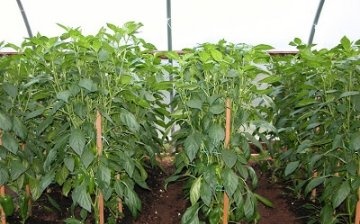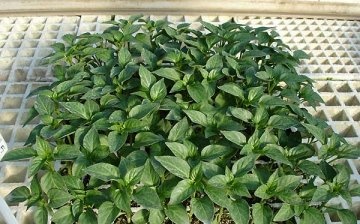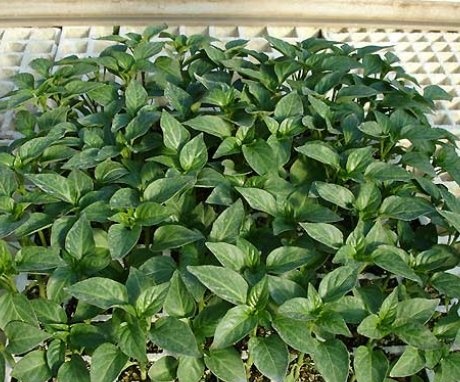Pepper transplanting is a simple process, but ...
Vegetable crops such as pepper in our country grows in open field conditions exclusively in the south. In other regions, its cultivation requires the use of greenhouses or greenhouses.
Content:
Pepper planting features
Planting pepper has its own characteristics: it must be planted in soil with a temperature of +15 - +16 degrees and above. Before transplanting the grown seedlings of this culture, it must be watered abundantly, then holes are formed according to the size of a lump of earth with which you transplant pepper. Fertilize each well by adding 1 tablespoon of potassium fertilizer to it. But it should be remembered that this fertilizer should not contain chlorine, which is harmful to pepper. The formed hole must be filled with water to the brim and left until it is completely absorbed into the soil. Seedlings pepper should not be deeply buried in the ground - we plant it at the level at which it grew before landing in the ground.
After transplanting, the soil should be compacted and watered around the plant, and also tied to the established pegs. The latter does not apply to undersized varieties. The distance between the bushes of seedlings should be sufficient so that rotting does not occur from waterlogging of the soil. When planting, each variety has its own nuances, often indicated on the package with the seeds of this variety.
After transplanting, you do not need to water the pepper for one week.
To prevent infection of young sprouts with aphids, pepper can be planted along the bushes. a tomato... Pepper can also coexist with cucumbers. Ideally, peppers should still be grown in a low, separate greenhouse, the height of which will not allow the air in it to cool much at night. This is due to the fact that this vegetable crop does not tolerate temperature changes. If, besides a high greenhouse, you still have no other place to plant peppers, then you have no choice but to use heating devices during the temperature drop at night. If you live in a cold climatic zone, then you will have to warm the ground to plant the pepper.
Transplanting seedlings into the ground
Is there anything new in the technique of transplanting pepper seedlings? Pepper transplanting has its own secrets - both new and well-known.
Pepper behaves like a whimsical plant in the early period of growth, as it reacts poorly to damage to the root system during this period.
To avoid damage to the lower part of the plant shoot, it should not be buried below its previous growth level, i.e. 3-4 cm deep into the soil. Since the seed coat of pepper is dense and does not absorb water well, the seed swelling period is extended longer than in other crops. The growing process of peppers is very slow and challenging in many ways, so you should be patient when growing this crop - but it's worth it, especially if you follow certain guidelines when doing it.
- First, we prepare polyethylene bags, making them from a film, the size of a sheet of A5 paper and filling them with a wet soil mixture. You can use an elastic band or paper clip to fix our workpiece. Then we leave them tightly standing in a container of the required size.
- Each bag must be marked with the number or variety of our plant.
- In the ground, we make a depression 1-1.5 cm, lower a grain of pepper there and pour a small amount of a solution that stimulates growth. The solution is most conveniently administered with a syringe or pipette (drip).For better formation of the root system and quick distillation of seedlings, you can use any solution suitable for this, for example: "Zircon", "Narcissus", "Epin-extra", "Novosil" and "Energen" are also suitable.
- Then cover the seeds with soil and compact with your finger. We place the bag in a transparent polyethylene bag, saturate it with carbon dioxide by exhaling into it and tighten it tightly.
- For the rapid and simultaneous germination of pepper seedlings, a temperature within 25 degrees Celsius is suitable. This will allow us not to dive our seedlings in the future. You just need to expand it and add 1 tablespoon to it. soil mixture, provided that 4-5 leaves appear on the stem. Due to the absence of picking in the future, the pepper takes root faster.
- As soon as a sprout appears on the surface, pepper should be moved to a cooler place, for a period of about 10 days. In this case, the backlight should be used, but not more than 8 hours per day.
- Feeds planted seeds immediately after planting.
- Watering pepper seedlings must be done in moderation.
- And on the eve of planting seedlings, we fertilize all the soil with "Gum" and "Fitosporin".
- The holes for the pepper should be dug at a distance of about 30 x 30 cm, adding dry hay or feathers to them, pour half a glass of hydrogel jelly and a liter of hot water into each, plant the seedlings directly on the gel, unrolling the diaper.
Since the root system of the pepper is quite compact, and it is very sensitive to a lack of moisture in the upper layers of the soil, it usually requires frequent watering, but when using a hydrogel, you will have to water no more than once every 2-3 weeks.











Nice and helpful article. I would like to add that we plant garlic between the seedlings of the Persian, since every year the root of the pepper is eaten up by the rodent and the fruit does not ripen. And that year they decided to try to do this, and all the peppercorns have matured.
For many gardeners, pepper is considered a difficult culture, it is very picky, often sick. And with the transplant all the time there are problems. And your good advice will help you avoid many problems. Thank you!